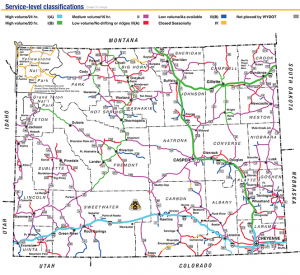WYDOT Priorities Could Mean More Snowfall Slowdowns in Bighorn Basin
Written by Andrew-Rossi on December 28, 2020
It’s getting colder and snowier – which means it’s a good time to review which roads are being prioritized for snow removal.
WYDOT has laid out its plan for the blizzardly weather ahead in its Snow Removal Operations Plan for Winter 2020-2021. The department’s plan, which accounts for resources, manpower, and funding, prioritizes the road and highways with the most traffic and any regional school bus routes.
The entire Bighorn Basin falls under District 5 – northwest Wyoming. In order to ensure traffic moves throughout the Basin regardless of weather, the department has several different levels of road maintenance that will directly affect your next trip.
D5 levels of snow plow service 12-22-2020
- Level 1A roads have 24-hour service … the only Level 1 (A) roads are the interstate highways in Wyoming – which there are none of in northwest Wyoming.
The only road that falls under this category is I-80 in southern Wyoming.
- Level 1B — Crews hope to provide service up to 20 hours a day with minimum service necessary that will allow traffic to move safely at a restricted rate … plowing methods and frequency should be sufficient to keep snow ridges and dangerous drifting to a minimum.
This category covers at least part of all the major roads through the major population centers in the Bighorn Basin – the highway from Thermopolis to Worland, Greybull, and Lovell, and the roads from Cody to Powell and Meeteetse. Regardless of the weather, these roads will be well covered.
- Level 2 — Crews strive to provide service up to 16 hours a day for traffic observing reasonable winter driving precautions. Plowing methods and frequency should be sufficient to minimize minor snow ridges and dangerous drifting.
Many routes between Bighorn Basin towns fall in this category, such as the road between Meeteetse and Thermopolis, Worland thru Ten Sleep to Buffalo, and parts of the highways between Cody and Greybull, and Powell to Lovell
These roads won’t be closed but they likely will not be cleared quickly, so be aware if you’re planning to take any of these routes during heavier snowfall.
- Level 3 — Crews provide minimum service necessary for traffic observing reasonable winter driving precautions and speeds. Plowing methods and frequency should be sufficient to minimize larger snow ridges and dangerous drifting during daylight hours; crews apply abrasives (sand/salt) and chemicals when necessary on hills, curves, and hazardous locations; and crews close the road when warranted by visibility limitations or other extreme situations. If necessary, crews allow roads to close because of the weather and reopen as soon as resources are available.
This is where things get a bit complicated . . .
Parts of the Greybull Highway fall under both Level 2 and Level 3, as does the route between Cody to the Montana border. The entire Chief Joseph Scenic Byway falls under this category, as does the Worland cutoff near Meeteetse. It’s best to expect and prepare for changing conditions on these stretches – the hills might be clearer than the long stretches.
- Level 4 roads — Crews close these roads in the fall as mandated by heavy snow and weather. Crews reopen these roads as soon as practical in the spring
These are roads won’t be touched until things get warmer. The best example of this in northwest Wyoming is the Beartooth Highway.
This plan is being implemented amidst the budget cuts WYDOT knows are coming. WYDOT director Luke Reiner has said that this will not stop roads from being plowed, but they may stay snowier longer and many of their snow elimination tools – magnesium, salt, and chloride – will be used more sparingly than in years past.
Categorizing Wyoming’s roads is done not only for WYDOT to achieve maximum efficiency, but also to ensure the state’s drivers are moving along as quickly as can be safely permitted. But much of the department’s plan relies on drivers being responsible: be mindful of road conditions, drive slower in slick conditions, and be prepared in the event you need to stop or are unable to continue driving.
If this all seems like a bit much, WYDOT has several resources available that will provide the most up-to-date information before you embark on your next journey:
- Dial 511 on your cell phone to obtain road information. This system can also be enabled to deliver road alerts as text messages to your phone or e-mails to your computer or phone on routes that the user identifies. Go to www.wyoroad.info and choose the 511 notify icon to set-up your account.
- National Weather Service (Riverton) – https://www.weather.gov/riw/
- WYDOT road conditions – www.wyoroad.info
- WYDOT road conditions – 1-888-WYO-ROAD
In case of emergency, the Wyoming Highway Patrol is available for assistance 24 hours a day by dialing (800) 442-9090.





